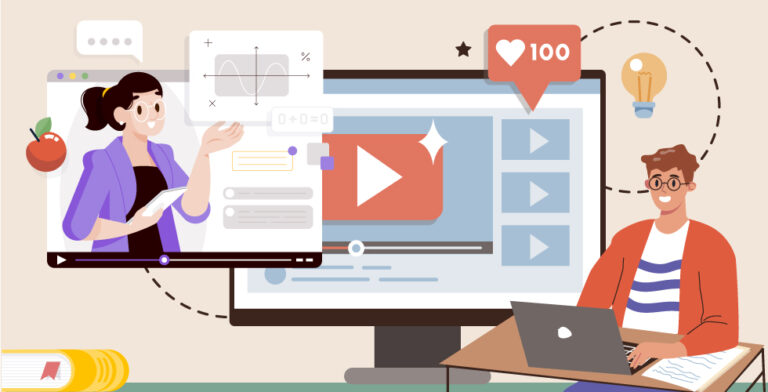The short answer is – “GIFs and animated videos mostly differ in format and design. While animated videos can be lengthy and may tell a story through a sequence of pictures and sound, GIFs are short, looping animations.”
GIFs are simpler to distribute on social networking sites and other online forums since they often have a lower quality and smaller file size than videos. On the other hand, videos have more room for delivering an upfront message and are frequently used in marketing, instruction, and entertainment.GIFs and animated videos may both be entertaining and interesting, but they have distinct uses and call for different design approaches. In this article, we are going to discuss the uncanny.
What is GIF?
The complete form of GIF is a Graphics Interchange format and it is a file format used to create simple images. GIFs are the type of bitmap images that can display up to 256 colors, and they use a lossless compression method to preserve picture quality maintaining a moderate picture size.

Key Characteristics
GIFs are picture and animation file formats having transparency support, minimal file sizes, loop constantly, and are generally compatible with web browsers and social networking platforms. GIFs may be used to create basic animations and visuals that can be placed on top of other pictures or backdrops. They are simple to upload and show on the internet, and their lopping characteristics make them perfect for making short, repetitive animations or memes because of their small file size. GIFs have grown in popularity as a tool to communicate emotions, sentiments, and ideas in digital communication.
Advantages
There are several advantages of GIFs- one of these being using GIFs as a form of expressing emotions as or making memes (jokes). In modern time, GIF is highly popular amongst youngsters especially because it is easy to create thus, expressed as an individual expression. People take any scene, image, or movie cut and can easily turn those into GIFs and use those to express their respective expressions especially, on social media. Numerous apps and websites allow you to create GIFs easily. In addition to that, GIFs can be quite versatile and are used to promote products or movies online.
What are Animated Videos?
Animation videos are the types of videos that use the technique of creating the illusion of motion using static images to bring those to life. Animate videos are created by drawing images or creating those digitally using formats like 2D or 3D or any other ones. Animated videos can be used for a variety of purposes, including entertainment, education, marketing, and advertising.
Key Characteristics
One of the key characteristics of animated videos is their visual appeal. The use of animation techniques allows for the creation of stunning visuals that are visually appealing and can capture the viewer’s attention. Another characteristic of animated videos is their flexibility. Unlike live-action videos, animated videos can be created in any style or form, allowing for a greater range of creativity and artistic expression. Animated videos also have the advantage of being easily customizable. Changes can be made to the animation or graphics relatively easily, allowing for modifications to be made quickly and efficiently.
There are different types of animated video formats, those are- 2D Animation, 3D Animation, Whiteboard Animation, Stop Motion Animation, Motion Graphics, Typography Animation, Cut-out Animation, Claymation, Puppet Animation, etc.
Advantages
Animated videos are becoming popular day by day due to their high acceptance by a wide range of audiences. It conveys a straightforward message which makes it effective for businesses, educators, and marketers alike. There are several advantages to using animated videos that make them an effective tool for businesses, educators, and marketers alike. One of the main advantages of animated videos is that they are highly engaging and attention-grabbing. The brilliant colors, sound effects, and voiceovers being used in animated videos have the ability to capture the attention of the audience giving them an immersive experience. Animated videos may also clarify difficult concepts and ideas, making them easier to learn and remember.
GIF vs Animated Video
In this time of digital age, both GIFs and animated videos are two popular forms of animation that had become quite popular amongst youngsters. They are used by businesses, educators, and marketers to convey their message to their audience in a visually engaging and memorable way. However, there are key differences between the two formats that can affect their suitability for specific applications. In this comparison, we will explore the differences between GIFs and animated videos in terms of their format, design and animation, length and file size, and usage and application. By examining these differences, we can gain a better understanding of the strengths and limitations of each format and how they can be effectively utilized to communicate a message to a target audience.
Key Differences in Format
Format of GIFs is like it has a sequence of pictures in a file format that plays in a loop and is short while Animated videos are a type of video file format that can show motion graphics, 2D or 3D art with sound, commentary, or voice over and with a deliberate target. In this case, both GIFS and animated videos have different formats and serve different purposes because of that.
Design and Animation
GIFs do not have complex design, it is rather simple to create by using some specific websites and applications dedicated to them. GIFs are also limited in terms of design and animation compared to animated videos. GIFs are typically created using a series of images or short clips and are often simple and repetitive in terms of animation. Animated videos, on the other hand, can be designed and animated using a range of techniques and styles, allowing for more complex and dynamic visuals.
Length and File Size
GIFs are usually short and have a limited file size due to their format. Animated videos, on the other hand, can be longer and have a larger file size due to their video format. This means that animated videos can display more complex and detailed animations and can convey a more in-depth message.
Usage and Application
GIFs are commonly used for social media and digital marketing purposes, such as creating eye-catching ads or memes. Animated videos, on the other hand, are used for a wider range of applications, such as education, training, entertainment, and marketing. Animated videos can convey complex ideas and concepts, making them ideal tools for instructional or educational purposes.
Wrapping Up
While both GIF and animated videos are one form of animation, they differ in terms of format, design, animation, length, usage, and application.
- GIFs are limited in terms of animation and length but are easy to create, share and use for multiple purposes including personal and marketing use.
- Animated videos are more complex to create and carry more contextual value. Animated videos contain intricate details and a good body of work that makes it simple for the audience to understand a topic.






